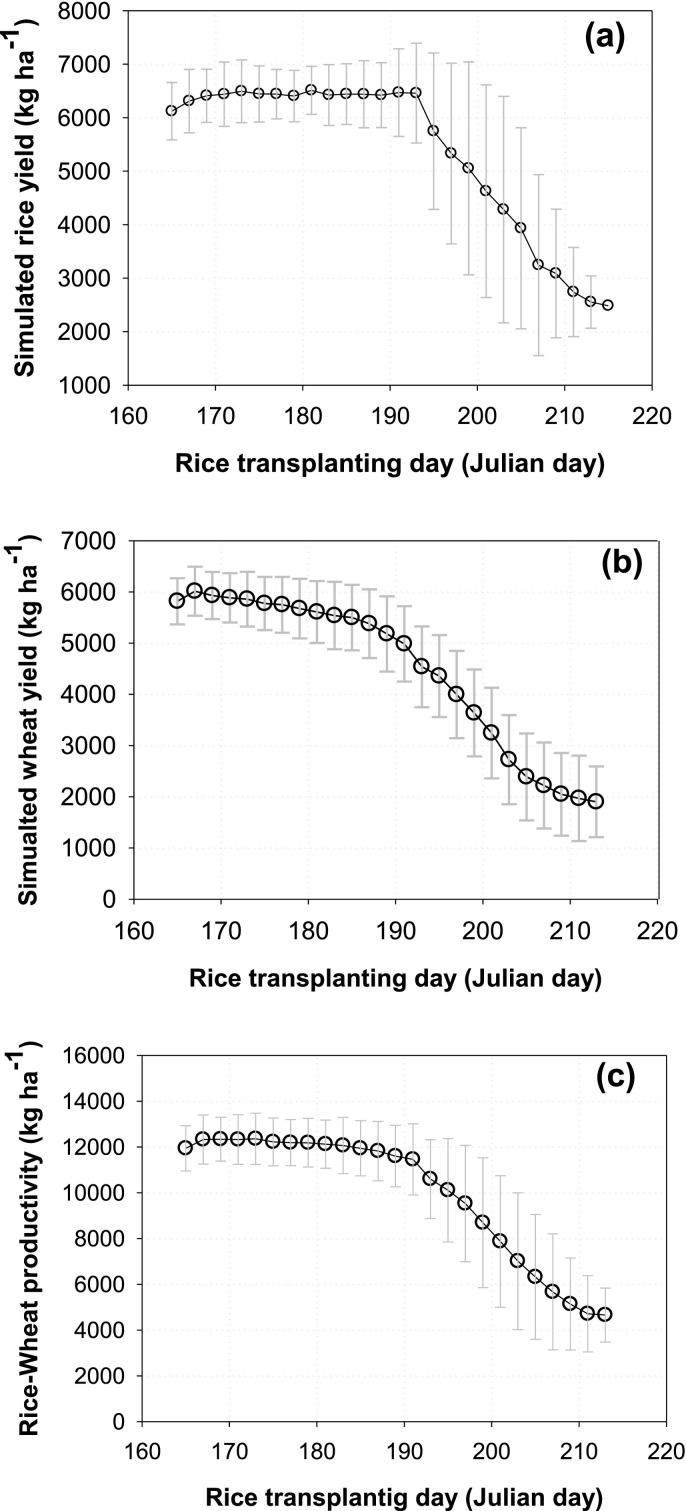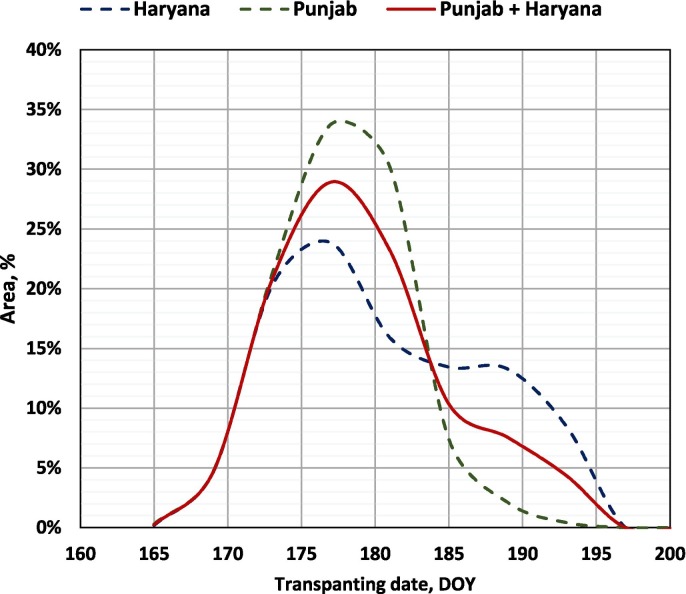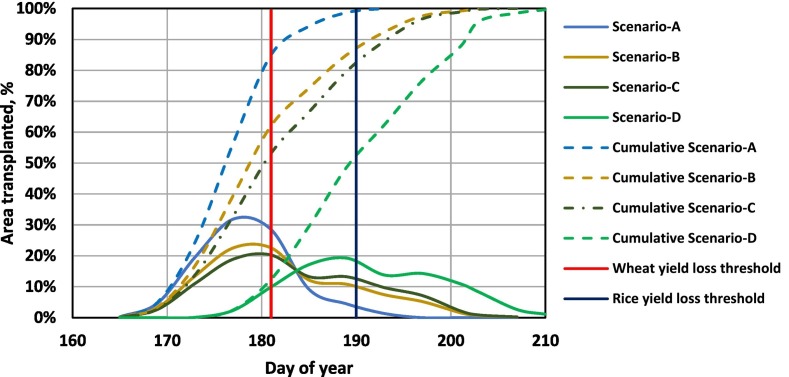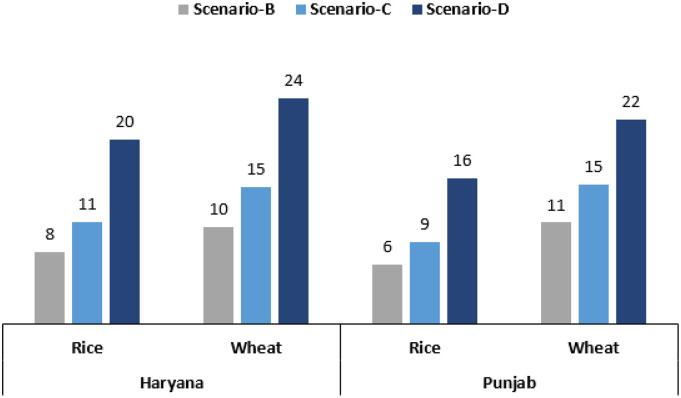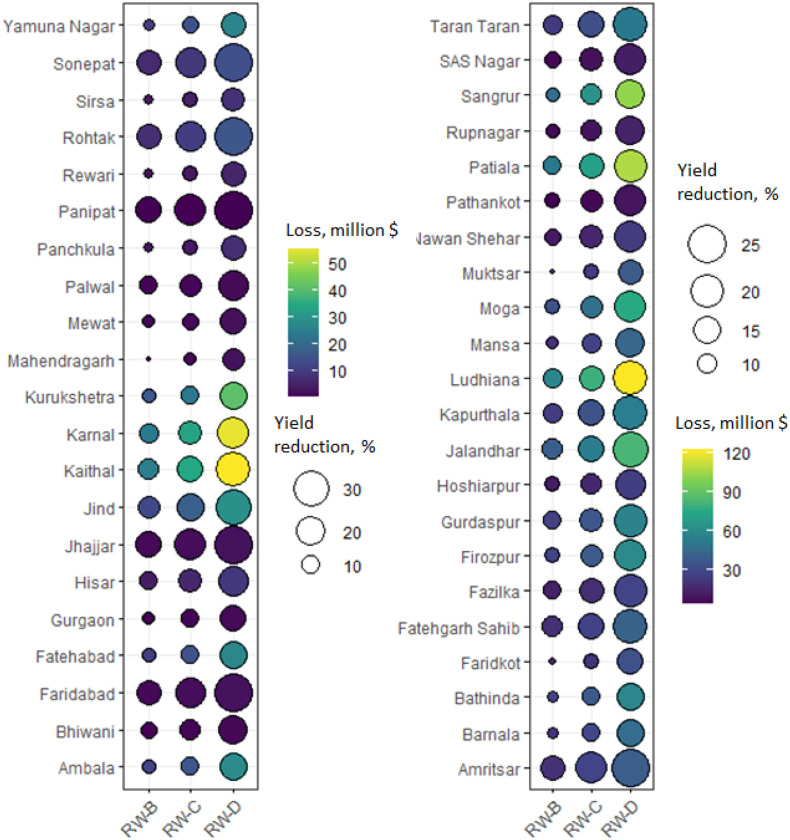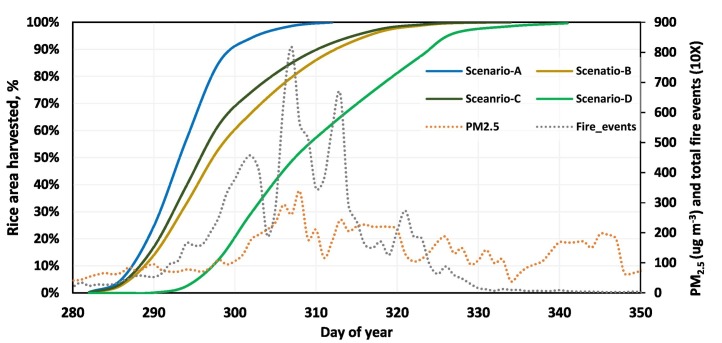Abstract
To contain the COVID-19 pandemic, India imposed a national lockdown at the end of March 2020, a decision that resulted in a massive reverse migration as many workers across economic sectors returned to their home regions. Migrants provide the foundations of the agricultural workforce in the ‘breadbasket’ states of Punjab and Haryana in Northwest India.There are mounting concerns that near and potentially longer-term reductions in labor availability may jeopardize agricultural production and consequently national food security. The timing of rice transplanting at the beginning of the summer monsoon season has a cascading influence on productivity of the entire rice-wheat cropping system. To assess the potential for COVID-related reductions in the agriculture workforce to disrupt production of the dominant rice-wheat cropping pattern in these states, we use a spatial ex ante modelling framework to evaluate four scenarios representing a range of plausible labor constraints on the timing of rice transplanting. Averaged over both states, results suggest that rice productivity losses under all delay scenarios would be low as compare to those for wheat, with total system productivity loss estimates ranging from 9%, to 21%, equivalent to economic losses of USD $674 m to $1.48 billion. Late rice transplanting and harvesting can also aggravate winter air pollution with concomitant health risks. Technological options such as direct seeded rice, staggered nursery transplanting, and crop diversification away from rice can help address these challenges but require new approaches to policy and incentives for change.
Keywords: Rice, Wheat, Burning, COVID, Labour shortage, PM2.5, Economic loss, Transplanting
Graphical abstract
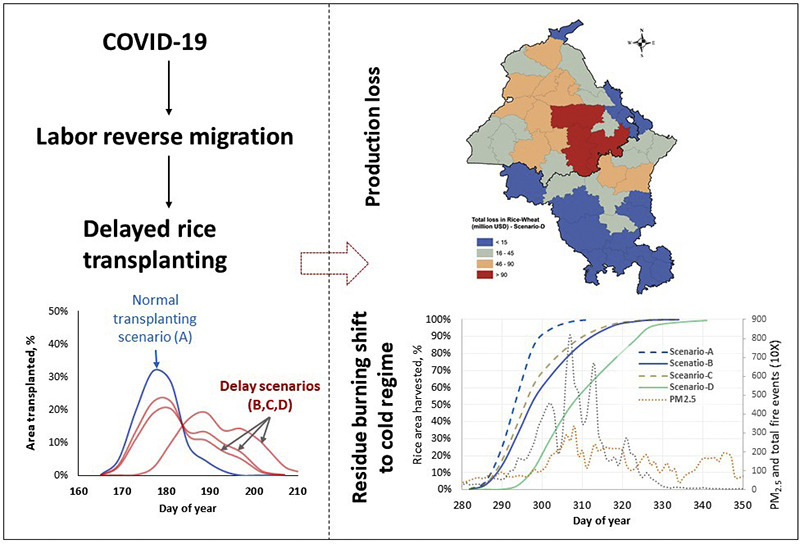
1. Introduction
COVID-19 is a rapidly evolving pandemic, with many rural and urban areas across the globe effectively shut down for most commerce and transport. Border closures, quarantines, and value chain disruptions are restricting food access, while shortfalls of inputs and the financial means to purchase them are jeopardizing production capabilities. Productivity is further threatened by emerging shortages of agricultural labour in some regions that may disrupt planting, harvest, and other farming operations.
Beyond current output market and harvesting disruptions that are impacting the end of the winter cropping cycle, the looming major forthcoming challenge is the narrow window for rice transplanting that happens across >30 million hectares at the beginning of the monsoon rainfall season. More than 95% of the rice area in India is dependent on manual labour for crop establishment and the lockdown has triggered a huge reverse migration from the northwestern states of Haryana and Punjab, with estimates suggesting that around 1 million labours have returned to their home states with little prospect of returning in the near future (Chaba and Damodara, 2020). Productivity shortfalls from Northwest India could have profound national-level food security ramifications since these two states contribute around 50% of the staple food grains that are procured and distributed by the Government of India (Chauhan et al., 2012, DPFP, 2020). Agriculture in this region is intensive, high input, and is dominated by rice (monsoon or kharif season) and wheat (rabi or winter season) crops grown in rotation. These systems have India's highest annual grain productivity per unit area land (Yadav et al., 2019). Rice-wheat system productivity is driven by timely transplanting of rice and, consequently, by the timely sowing of the succeeding wheat crop in rotation. Most of the rice is transplanted during a short two-week window starting mid-June.
We hypothesize that reverse migration of farm labour, coupled with social distancing restrictions, will significantly delay the transplanting of rice with a consequent delay in wheat seeding in Northwest India (i.e. states of Punjab and Haryana). Not only may this significantly reduce rice-wheat production, but rice harvesting delays may also lead to damaging shifts in rice residue burning to periods in the later fall where weather conditions favor poor air quality (Balwinder-Singh et al., 2019a). During the peak pollution period in November and early December, rice residue burning is a significant source of PM2.5 in the region. This broadly affects rural and urban communities, including the capital New Delhi (Cusworth et al., 2018), with 3-fold increases in acute respiratory illnesses observed in the most fire-affected districts (Chakrabarti et al., 2019). The spiking of air pollution in the winter months in northern India already constitutes a serious health problem, and may exacerbate the threat of COVID-19 by increasing both infection rates and disease severity. In this paper, we present a spatial ex ante assessment of the potential impacts of labor-induced crop establishment delays in the rice-wheat systems of Northwest India from the perspectives of agricultural production and air pollution. Further, we suggest potential technological solutions which may help cope with the anticipated labour shortages associated with the pandemic while contributing to agricultural sustainability in the region.
2. Materials and methods
Agricultural systems in Northwestern India are highly dependent on the work of economic migrants (Kaur et al., 2011) and COVID-19 has resulted in an exodous of these workers returning to their home states, creating wide-spread labour shortage across economic sectors (Gupta, 2020; Mukhra et al., 2020). We developed rice transplanting delay scenarios based on expert judgement that represent a range of plausible delays conditioned by anecdotal evidence that dependence on hired labour increases as farm size increases. Time-series satellite imagery are used to characterize the current rice and wheat crop planting and harvest date trends in the Northwestern Indian states of Punjab and Haryana. We then used farm size data (Fig. 1 ) to calculate the rice transplanting date distributions on an area basis for each scenario. We then use this information to initialize the APSIM cropping system model (Balwinder-Singh et al., 2019a, Balwinder-Singh et al., 2019b; Balwinder-Singh et al., 2016) to examine the effects of rice sowing date on both rice and wheat productivity and then used rice crop duration from simulated data for each transplanting date to develop rice harvesting date distribution scenarios.
Fig. 1.
Farm size distribution in Punjab and Haryana states.
2.1. Satellite-based assessments on crop characteristics
Rice and wheat establishment dates, maturity dates, and total sown area were derived using high temporal resolution satellite data. We used MOD13Q1 (Terra) and MYD13Q1 (Aqua), Vegetation Indices (VI) 16-Day L3 Global 250 m product of MODIS from 2018 to 2019. Each image gives the maximum value of the enhanced EVI (Enhanced Vegetation Index) over a 16-day compositing window with an 8-day offset between the two products, yielding EVI estimates at 8-day intervals when used together.
To extract crop phenology data, we used 50 images of MODIS EVI data for last two rice seasons (2018–2019). The Savitzky-Golay function in TIMESAT was used to smoothen the noise and subsequently fit time-series data on a pixel-by-pixel basis. Based on Balwinder-Singh et al., 2019a, Balwinder-Singh et al., 2019b, we separated rice areas from other landuses by using a maximum EVI threshold value (> 0.5) and field duration criteria (112 to 152 days) for rice during the monsoon season. Thereafter rice transplanting date was estimated on a 250 m2 pixel basis by assessing when a rice crop achieved 10% of maximum EVI on the ascending limb of growth curve; actual transplanting is likely to be 2–3 weeks earlier and we adjusted our statellite estimates by 15 days accordingly (Boschetti et al., 2009). We then used crop maturity criteria (i.e. 10% of peak EVI on the descending limb of growth curve) to assess crop readiness for harvest.
2.2. Rice transplanting scenarios in Northwest India (Punjab and Haryana)
-
A.
Business as Usual: In this scenario, we assume no delays in rice transplanting and farmers manage to plant rice on time though family labour, hired labour, or mechanized planting. Rice transplanting was based on the average planting date of last two years (2018 and 2019) as estimated by satellite data. We choose the last two years over the long-term average because they reflect a recent increase in the use of shorter-duration rice varieties, although many farmers still cultivate medium or longer-duration cultivars. This transition has been provoked, in part, by policy mandate by the state governments to delay rice transplanting till the third week of June in order to conserve groundwater resources for irrigation.
-
B.
Medium (4-10 ha) and large (>10 ha) farmers won't get access to sufficient labour and other resources for transplanting: In this scenario, we assume that both medium and large farms (i.e. > 4 ha, Fig. 1) are not able to transplant rice on time. Here we anticipated that paddy transplanting in 50% of land owned by medium and large farmers will be delayed by one week and remaining 50% by two weeks. Farm size information is only available to district levels, hence we used fractional area under medium and large farm-size class to estimate the total rice area covered by each delay category in each district. For example in Ludhiana district in Punjab, the areal extent of >4 ha farms is 33% which was equally distributed to all transplanted dates starting from 165 DOY and onwards. The districts which have large areas under farm size >4 ha have more risk for transplanting delay. Other farms transplant rice according to scenario A.
-
C.
Semi-medium (2-4 ha), medium and large farmers won't get access to sufficient labour and other resources for transplanting: In this scenario all assumptions like area distribution under delay transplanting are same as Scenario B, but we assume that the labour shortage effect extends to farm sizes equal to or greater than 2 ha. We assume that out of total rice area occupied by these farms in each district, 50% transplanting is delayed by one week and remaining 50% by two weeks.
-
D.
All categories of farmers won't get access to sufficient labour and other resources for transplanting: In this scenario we assume a delay in transplanting everywhere (i.e. not considering the farm size differences in labor availability). These delays, however, are modelled in a staggered manner; 50% of total area in both states is subjected to delay of one week, 25% area by two weeks and remaining 25% by three weeks.
2.3. Cropping system simulations
The APSIM model (Holzworth et al., 2014) was used to simulate the effect of the different sowing date scenarios on rice-wheat system productivity. APSIM was calibrated and performance verified in the same region in previous studies (Balwinder-Singh et al., 2015; Balwider-Singh et al., 2011) (Rice; r2 = 0.91, RMSE = 200 kg ha−1; Wheat; r2 = 0.86, RMSE =550 kg ha−1) and has performed well in simulating rice and wheat yields under contrasting environments across Asia (Gaydon et al., 2017). Simulations were run on a silty loam soil for medium duration rice variety (135–140 d) and wheat variety (150 d) using CSISA (www.csisa.org) project data from Karnal, Haryana. The soil has a plant available water capacity (PAWC) of 110 mm over the top 60 cm and 290 mm to a soil depth of 180 cm (Table 1, Supplementary material). The stage 1 soil evaporation parameter (U) was set to 12 mm, and the stage 2 parameter (cona) was set to 4 mm. The saturated percolation rate was set to 20 and 6 mm d−1 for non-puddled (at time of wheat sowing) and puddled soil. Soil water and nitrogen values were reset in each simuated year at 15 days before rice sowing, to capture the effect of inter-seasonal climate variability on rice-wheat yield. All simulations were conducted using 24 years (1991–2015) of weather data from the Ludhiana (Punjab) and Karnal (Haryana) sites. To study the effects of the rice transplanting date on rice and the following wheat crop yield (pixel basis), and on total system yield, the calibrated model (for rice and wheat cultivars)was used to evaluate the performance of rice-wheat system under different transplanting dates starting from 15 June to 5 August for rice at 2-day increments. Rice crop simulations used 25-day old seedlings transplanted at 33 plants m−2 and nitrogen was applied at 150Kg ha−1. The crop was irrigated daily after transplanting as needed to maintain continuous ponding (depth 50 mm) for the first two weeks after transplanting. Thereafter, the crop was irrigated three days after disappearance of the ponded water, and the amount of water added was the amount required to fill the top two soil layers (0–30 cm) to saturation plus an additional 50 mm water. The rice crop was followed by wheat sown 21 days after rice maturity to allow for the farmers practice of drying, harvesting, crop and field preparation for the wheat crop after pre-sowing irrigation. Wheat was sown using conventional tillage with one pre-sowing irrigation of 70 mm applied 15 days after rice maturity. The wheat variety was PBW343 sown at 150 plants m−2 with a row spacing of 20 cm. The crop was irrigated when the soil water content (0–60 cm) decreased to 50% of plant available water content and nitrogen was applied at 150 Kg ha−1.
2.4. Economic loss
For each scenario, we estimated yield changes over baseline (Scenario-A) at pixel level as a function of transplanting date for rice and wheat. These yield changes are then applied to district level production data (DACNET, 2018–2019) of rice and wheat to calculate the changes in the total production. These two states cultivate both coarse rice as well as basmati (aromatic) rice; the analysis here focuses only on coarse rice. Area under coarse rice was calculated using district level percentage share of Basmati rice (Agricultural and Processed Food Produts Export and Development Authority (APEDA), 2019). Since this analysis highlights transplanting delays and its effects on the rice-wheat cropping system, the wheat area modelled is the same as the rice area. For estimating economic losses, we used minimum support price (USD $215 for rice and $278 for wheat; assuming 1 USD = 72 INR) as the basis for calculations; minimum support price is an assured procurement price for these commodities in Punjab and Haryana. It should be noted that the evaluated scenarios only consider transplanting delays and assume that all other management factors including the age of rice seedlings remain the same across scenarios.
2.5. Fire data
The Visible Infrared Imaging Radiometer Suite (VIIRS) fire product from NASA/NOAA Suomi National Polar-orbiting Partnership (Suomi NPP) satellites at 375 m spatial resolution was used to estimate the number of fires per day for year 2018 and 2019 from 1 October to 31 December. The VIIRS data is more sensitive for smaller and cooler fire (Csiszar et al., 2014; Schroeder et al., 2014), which is often the case for agricultural residues. Low confidence values data in the VIIRS fire products were excluded from the analysis and remaining nominal and high confidence values were considered in the analysis to estimate fires per day.
3. Results
3.1. Rice and wheat yield under different rice transplanting dates
APSIM simulations using long-term weather data showed a similar yield for all transplanting dates during June and till 9 July, with maximum median yield of about 6.5 t ha−1 (Fig. 2a). Rice yield declined sharply after 9 July and further delay in transplanting to 2 August resulted in significantly lower median yield of 2.4 t ha−1. The highest variance in rice yields was observed under July transplanting dates. Under far later sowings in early August, variability was low but yields levels were also very low. The best combination of high and stable rice yields was observed till 9 July (190 DOY) transplanting dates. Under the scenario of transplanting after 9 July, rice yield declined at 1.2% per day delay. The succeeding wheat crop, sown 21 days after of rice maturity in every case, was more sensitive to the timing of rice establishment with yield declines started after 180 DOY (Fig. 2b). Therefore, on a system basis, the rice-wheat productivity declined significantly when rice transplanting was done after 30 June or 181 DOY at rate of 0.75%, however system productivity decline very sharply after 190 DOY rice transplanting at 2.4% per day in delay. (Fig. 2c).
Fig. 2.
Simuated rice yield (a), wheat yield (b) and rice-wheat system yield (c) in kg ha−1 under different rice transplanting dates. Rice transplanting dates are Day of year, 160 = 9 June to 220 = 8 August. Errror bars representing one standard deviation either side of the mean.
Satellite data analyzed for past two years (2018–2019) indicates that in both Punjab and Haryana states (Fig. 3 ), almost 100% of the area is transplanted during the optimum window for rice productivity (i.e. before 190 DOY); Fig. 2a). However, in Haryana roughly 35% of the rice area is transplanted after 30 June (DOY 181), the date afterwhich delayed rice sowing increases yield penalties for wheat (Fig. 2b). In Punjab only 10% of the rice area is planted after 30 June.
Fig. 3.
Percentage area by rice transplanting date for Punjab (green line) and Haryana (blue line) during the 2018 and 2019 cropping seasons. Red line is the cross-state average. (For interpretation of the references to colour in this figure legend, the reader is referred to the web version of this article.)
In transplanting delay scenarios B, C and D, based on model runs with long-term climate data suggests that 15%, 20% and 51% of the total area incurring rice yield losses (transplanting beyond 190 DOY) (Fig. 4 ) across both states. However, the wheat area projected to fall under significant yield loss window (i.e. due to rice transplanting beyond 30 June) are significantly higher at 38%, 47%, and 87%% for scenarios B, C, and D, respectively under both states (Fig. 4).
Fig. 4.
Distribution of rice area (%) by transplanting dates under constrasting scenarios of labor availability. Red and Blue vertical lines represent threshold dates beyond which wheat and rice yield penalties start, respectively. (For interpretation of the references to colour in this figure legend, the reader is referred to the web version of this article.)
Simulated yield outcomes under plausible transplanting delay scenarios from COVID-19 indicates less impact on the rice yields, but the potential for significant losses for wheat. The magnitude of productivity loss, i.e. area × yield over baseline, will also vary with rice and wheat planting date (Fig. 2). Among the rice transplanting delay scenarios, the highest rice production loss, was under scenario D with Haryana experiencing higher losses (20%) than that of Punjab (16%) (Fig. 5 ). On an average across both states, projected rice production losses vary from 7% to 18.0% in scenario B to D. The wheat production yield loss trends in both states are similar to, but in higher quantities, than that of rice.
Fig. 5.
Percentage Rice and Wheat production losses as compare to scenario A (‘baseline’) under different rice transplanting delay scenarios.
On a district-scale, which is the functional planning unit for policy implementation in India, reductions in system-level production vary from 13% to 26% in Punjab and 13.0% to 35% in Haryana under scenario D where maximum production losses were observed (Fig. 6 ). This micro-scale analysis will be highly helpful to the planners for targeting investments for immediate coping measures and technologies and their effective implementation in this agriculturally important region of the world.
Fig. 6.
District-wise extent of yield loss (%) and production basis economic loss (million US$) under different rice transplanting scenarios. Size of symbol represent the %age yield loss and colour represent the economic loss based on total production in district.
3.2. Economic loss
In addition to jeopardizing food security, projected rice-wheat system production losses would come at substantial economic costs. The highest total combined economic loss is around USD $1.48 billion (Punjab- US $1140 m and Haryana- $337 m) in scenario D. For scenario B and C, the combined losses for both states are estimated at USD $675 and US $935 m, respectively. In Punjab maximum economic loss is expected in Ludhiana District ($123 m) whereas it is projected to be highest in Kaithal District ($58 m) in Haryana. (Fig. 6).
3.3. Impacts on residue burning
Under ‘business as usual’ (scenario A), about 90% rice in Punjab and Haryana is harvested (from simulation data) by the last week of October, resulting in daily fire events and PM2.5 levels peaking in the first week of November (observed data). Average PM2.5 levels during 2018 and 2019 winter season follow the trends of average rice residue burning events during the same period, and attains peak in first week of November before declining as fire events also starts going down. Transplanting delay scenarios will result in later rice harvesting and will have a direct impact on the timing of rice residue burning. For scenarios B, C, D, our results (Fig. 7 .) suggest that between 30 and 80% rice residues will be burnt later, shifting the residue peak and prolonging the burning season in all the change scenarios. Also the residue burning will fall in more cooler time of year (mid to late November) as compare to the contemporary situation, likely further exacerbating agriculture's contribution to hazardous air quality.
Fig. 7.
Cumulative rice area harvesting trends under different scenarios and historical (2018 & 2019) number of fire events and PM2.5 (2018 & 2019) data over centeral Delhi (Available at https://app.cpcbccr.com/ccr/#/caaqm-dashboard-all/caaqm-landing).
4. Discussion
4.1. Potential impacts on food security, air quality, and public health
In the intensive rice-wheat rotation of Northwest India, ensuring timely rice establishment heavily relies on manual transplanting by migratory labour; Punjab alone requires 50 million person-days for planting of monsoon crops, primarily rice (Dhillon and Vatta, 2020). However, the COVID-19 crisis has led to significant reverse migration of labour. In the absence of viable near-term alternatives to support rice transplanting such as mechanized rice planters or the repurposing of labour from employment guarantee schemes (e.g. MGNREGA), the transplanting of rice will very likely be delayed in 2020. Our analysis suggests that this will have very significant implications for food security through yield loss in both rice and wheat, as well as for air pollution that may aggravate long-standing public health problems while increasing vulnerability to COVID-19 (McDonad et al., 2020).
Our analysis under different rice transplanting scenarios due to COVID-19 effects on labour availability indicates that potential delays in rice transplanting would significantly reduce rice production (around 7% - 18% loss) in Punjab and Haryana (Fig. 5). Under conditions where labor is not limiting, the turn-around time between rice harvesting and optimal planting window for wheat is already very narrow (around 2–3 weeks). Any delay in planting and harvesting of rice has significant implications for wheat planting and yields, and in absence of any adaptive measures, there could be significant wheat production loss. Our scenario analysis also showed that with delayed transplanting, it can lead to significant loss in wheat production (ranging from 10 to 23% under different scenarios) and total system production loss (from 9%–21%) (Fig. 5). The contribution of Haryana and Punjab to the central food stocks procured by Food Corporation of India and other agencies is about 65% for wheat and 34% for rice (https://dfpd.gov.in/). Therefore, any significant impact on the wheat and rice production in Northwest India would impact national food security. Our analysis indicates that if rice transplanting is delayed by one to three weeks in some areas scenario D), then total rice and wheat production in the kharif and following rabi season may go down by 4.6 million tons. In India, rice and wheat provides 60–70% calories and 50–55% protein in-take (Bishwajit et al., 2013), hence any reduction in production may directly or indirectly (e.g. through prices spikes) affect the food and nutrition security of resource-poor households.
The cities that fall in the study region are among the top 10 most air-polluted cities of the world. During November and early December, the peak air pollution period, rice residue burning is a significant source (7–79%) of PM2.5 in the region that broadly affects rural and urban communities, including the capital New Delhi (Bikkina et al., 2019; Cusworth et al., 2018). Seasonal PM2.5 trends are highly correlated with residue burning in the airshed i.e. Punjab and Haryana states (Cusworth et al., 2018; Liu et al., 2018). Long term analysis of PM2.5 data over North India showed that stable atmospheric conditions, indicated by low boundary layer depth and low wind speed, resulted in higher PM2.5 concentration during the winter months (Chowdhury et al., 2019). In all the transplanting delay scenarios modelled in our analysis, residue burning will be pushed towards a more cooler time of year(Fig. 7). This dimension could worsen an already acute air quality crisis. Recent research evidence indicates that living in a district with intense agricultural residue burning during winter months is associated with a three times higher risk of Acute Respiratory Infection (Chakrabarti et al., 2019); there is a large overlap between causes of deaths of COVID-19 patients and the diseases that are affected by long-term exposure to fine particulate matter (PM2.5) (Ogen, 2020; Wu et al., 2020). In all scenarios, the spike in air pollution in the winter months, caused in part, by rice residue burning, could coincide with an anticipated COVID resurgence in the fall, potentially making the public health impacts more severe by increasing both morbidity and mortality rates (McDonad et al., 2020).
4.2. Response options to cope with projected labor bottlenecks
Management practices and technologies exist that can help avoid or alleviate the consequences of labor delays, although there are significant challenges to bringing solutions to scale in the very near term. In descending order of near-term feasibility, options include:
4.2.1. Delay/staggered nursery sowing
Any delay in transplanting due to labour shortage can result in use of old (aged) seedlings. Seedling age at transplanting is an important factor for uniform stand of rice (Paddalia, 1980) and regulating its growth and yield (Sarwar et al., 2011). By delaying nursery sowing to better match delays in transplanting, yield potential can be conserved for rice.
4.2.2. Direct drilling of wheat using happy seeder
Direct seeding of wheat into rice residues using the Happy Seeder (Sidhu et al., 2015) can reduce the turn-around time between rice harvest and wheat sowing by 7–10 days and potentially eliminate the need of residue burning. With the COVID-19 mediated delayed transplanting, this window is expected to be further narrowed in winter 2020. A high-level analysis using public and private cost and benefits to explore feasible, affordable and scalable alternatives to crop residue burning suggests that use of no-till direct drilling using happy seeder is a potential solution (Shyamsundar et al., 2019) in addition to contributing to several sustainable development goals (Jat et al., 2020, Jat et al., 2019).
4.2.3. Directly sown rice
Timely planting of rice can also be achieved by adopting dry direct seeding of rice (DSR) using mechanized seed-cum-fertilizer planters. In addition to reducing the labor requirement for crop establishment, dry direct seeding allows earlier rice planting due to its lower water requirement for establishment. Furthermore, direct-seeded rice matures 8–10 days earlier than puddled transplanted rice, leading to an earlier harvest and timely establishment and higher yield of the following wheat crop (Balwinder-Singh et al., 2019b; Kumar and Ladha, 2011; Chakraborty et al., 2017).
4.2.4. Crop diversification with maize
Replacing rice with maize in the monsoon season is another option to alleviate the potential shortage of agricultural labour due to COVID-19 since mechanized crop establishment is the prevailing practice. Research evidence generated over past decade (Jat et al., 2020, Jat et al., 2019, Choudhary et al., 2018; Gathala et al., 2013) demonstrates that maize along with modern agronomic management practices can provide a profitable and sustainable alternative to rice. The diversification of rice with maize can potentially contribute to ecosystem services that includes conserving ground water, improving soil health and reducing air pollution through eliminating residue burning. Nevertheless, maize is more sensitive to water logging and soil salinity than rice and geographic opportunity targeting is a must. Proactive policies such as assured markets and critical infrastructure development are likely necessary steps to facilitate diversification away from rice.
In addition to above mentioned options, adoption of shorter duration rice varieties that maintain yield potential even with later transplanting, increasing the cropped area of basmati rice, and mechanical transplanting can address the challenges posed by rice establishment delays.
4.3. Limitations of the study
This study presented a scenario based analysis of implications of reverse labour migration as a result of COVID-19 on food security and air quality in the breadbasket of India. The transplanting delay scenarios described here and their effect on crop productivity are captured through the crop simulation model. The crop simulation models captures abiotic responses to delay on crop productivity, however, there may be shifts in pest and disease regimes (Chander and Mohan, 2020; Prasad, 2020) which are not accounted for in this study. Further, the crop response to delay might vary based on management practices and biophysical resources which, at this stage, owing to unavailability of datasets have not been accounted for.
5. Conclusion
The intensive and high yielding rice-wheat system in Northwest India generally occupies an optimum planting window that ensures high yields for both crops. Labor shortages caused directly and indirectly by the COVID-19 pandemic may significantly delay rice establishment with cascading effects on systems level productivity. Our simulation suggest that in the states of Punjab and Haryana, highly significant production (~24%) and economic losses (US$ 1.5 billion) are possible. In addition, delayed rice transplanting may exacerbate seasonal air pollution associated with agricultural burning, an outcome that may contribute to a COVID resurgence in the fall. Technological and management innovations can help address emerging constraints, but none can be readily taken to scale without concerted and strategic policy interventions.
Declaration of Competing Interest
None.
Acknowledgements
The research was supported by Indian Council of Agricultural Research (ICAR), Government of India, CGIAR Research Programs (CRPs) on Climate Change, Agriculture and Food Security (CCAFS) and Wheat Agri-Food Systems (WHEAT). The CCAFS receives support from CGIAR Fund Donors and through bilateral funding agreements (https://ccafs.cgiar.org/donors).
Footnotes
Supplementary data to this article can be found online at https://doi.org/10.1016/j.agsy.2020.102954.
Appendix A. Supplementary data
Supplementary material
References
- Agricultural and Processed Food Produts Export and Development Authority (APEDA) Western Uttar Pradesh and Parts of Jammu & Kashmir. Geotrans Technologies Pvt. Ltd., Basmati Export Development Foundation, APEDA; New Delhi: 2019. Basmati Survey - Report-1., Basmati Acreage & Yield Estimation in Punjab, Haryana, Delhi, Uttarakhand, Himachal Pradesh; p. 52. [Google Scholar]
- Balwider-Singh, Gaydon D.S., Humphreys E., Eberbach P.L. Evaluating the performance of APSIM for irrigated wheat in Punjab, India. Field Crop Res. 2011;124:1–13. [Google Scholar]
- Balwinder-Singh, Humphreys E., Yadav Sudhir, Gaydon D.S. Options for increasing the productivity of the rice-wheat system of north-west India while reducing groundwater depletion. Part 1. Rice variety duration, sowing date and inclusion of mungbean. Field Crop Res. 2015;173:68–80. [Google Scholar]
- Balwinder-Singh, Humphreys E., Gaydon D.S., Eberbach P.L. Evaluation of the effects of mulch on optimum sowing date and irrigation management of zero till wheat in central Punjab, India using APSIM. Field Crop Res. 2016;197:83–96. doi: 10.1016/j.fcr.2016.08.016. [DOI] [PMC free article] [PubMed] [Google Scholar]
- Balwinder-Singh, McDonald A.J., Srivastava A.K., Gerard B. Tradeoffs between groundwater conservation and air pollution from agricultural fires in northwest India. Nat. Sust. 2019;2:580–583. [Google Scholar]
- Balwinder-Singh, McDonald A.J., Kumar Virender, Poonia S.P., Srivastava A.K., Malik R.K. Taking the climatic risk out of directly sown and transplanted rice in Eastern India: insights from agro-climatology and dynamic simulation. Field Crop Res. 2019;239:92–103. doi: 10.1016/j.fcr.2019.05.014. [DOI] [PMC free article] [PubMed] [Google Scholar]
- Bikkina S., Andersson A., Kirillova E.N. Air quality in megacity Delhi affected by countryside biomass burning. Nat. Sustain. 2019;2:200–205. [Google Scholar]
- Bishwajit G., Sarkar S., Kpoghomou, Marce-Amara, Gao H., Jun L., Yin D., Ghosh S. Self-sufficiency in rice and food security: a south Asian persepective. Agric Food Secur. 2013;2:10. [Google Scholar]
- Boschetti M., Stroppiana D., Brivio P.A., Bocchi S. Multi-year monitoring of rice crop phenology through time series analysis of MODIS image. Int. J. Remote Sens. 2009;30:4643–4662. [Google Scholar]
- Chaba A.A., Damodara H. The Indian Express; 2020, April 30. The Covid Nudge: Labour Shortage makes Punjab, Haryana Farmers Switch from Paddy to Cotton.https://indianexpress.com/article/india/covid-19-punjab-haryana-farmers-paddy-cotton-6385600/ [Google Scholar]
- Chakrabarti S., Khan M.T., Kishore A., Roy D., Scott S.P. Risk of acute respiratory infection from crop burning in India: estimating disease burden and economic welfare from satellite and national health survey data for 250 000 persons. Int. J. Epidemiol. 2019:1–12. doi: 10.1093/ije/dyz022. [DOI] [PMC free article] [PubMed] [Google Scholar]
- Chakraborty D., Ladha J.K., Rana D.S., Jat M.L., Gathala M.K., Yadav S., Rao A.N., Ramesha M.S., Raman A. A global analysis of alternative tillage and crop establishment practices for economically and environmentally efficient rice production. Nat. Sci. Rep. 2017;7:9342. doi: 10.1038/s41598-017-09742-9. [DOI] [PMC free article] [PubMed] [Google Scholar]
- Chander S., Mohan B. Effect of planting date of rice on brown planthopper. Indian J. Entomol. 2020;82(2):277–279. [Google Scholar]
- Chauhan B.S., Mahajan G., Sardana V., Timsina J., Jat M.L. Productivity and sustainability of the rice-wheat cropping system in the indo-Gangetic Plains of the Indian subcontinent: problems, opportunities, and strategies. Adv. Agron. 2012;117:316–355. [Google Scholar]
- Choudhary K.M., Jat H.S., Nandal D.P., Bishnoi D.K., Sutaliya J.M., Choudhary M., Yadvinder-Singh, Sharma P.C., Jat M.L. Evaluating alternatives to rice-wheat system in western Indo-Gangetic Plains: crop yields, water productivity and economic profitability. Field Crop Res. 2018;218:1–10. [Google Scholar]
- Chowdhury S., Dey S., Girolamoc L.D., Smith K.R., Pillarisetti A., Lyapustine A. Tracking ambient PM2.5 build-up in Delhi national capital region during the dry season over 15 years using a high-resolution (1 km) satellite aerosol dataset. Atmos. Environ. 2019;204:142–150. [Google Scholar]
- Csiszar I., Schroeder W., Giglio L., Ellicott E., Vadrevu K.P., Justice C.O., Wind B. Active fires from the Suomi NPP visible infrared imaging radiometer suite: product status and first evaluation results. J. Geophys. Res. Atmos. 2014;119:803–816. doi: 10.1002/2013JD020453. [DOI] [Google Scholar]
- Cusworth D.H., Mickley L.J., Sulprizio M.P., Liu T., Marlier M.E., DeFries R.S., Guttikunda S.K., Gupta P. Quantifying the influence of agricultural fires in Northwest India on urban air pollution in Delhi, India. Environ. Res. Lett. 2018;13:044018. [Google Scholar]
- Dhillon B.S., Vatta K. 2020. https://www.tribuneindia.com/news/features/covid-cloud-over-farm-sector-73533
- DPFP 2020. https://dfpd.gov.in/food-grain-bulletin.htm
- Gathala M.K., Kumar V., Sharma P.C., Saharawat Y.S., Jat H.S., Singh M., Kumar A., Jat M.L., Humphreys E., Sharma D.K., Sharma S., Ladha J.K. Optimizing intensive cereal-based cropping systems addressing current and future drivers of agricultural change in the northwestern indo-Gangetic Plains of India. Agric. Ecosyst. Environ. 2013;177:85–97. [Google Scholar]
- Gaydon D.S., Balwinder-Singh P.L., Poulton H., Horan B., Ahmad F., Ahmed S., Akhter I., Ali R., Amarasingha A.K., Chaki B.U. Choudhury, Darai R., Hochman Z., Hosang E.Y., Li T., Kumar V.P., Khan A.S.M.M.R., Malaviachichi W., Rai G.S., Rashid U., Rathanayake M.M., Sarker D.K., Sena M., Shamim N., Subash L.P., Suriyagoda A., Suriadi T., Veasna R.K. Yadav, Roth C.H. Evaluation of the APSIM model in cropping systems of Asia. Field Crop Res. 2017;204:52–75. [Google Scholar]
- Gupta V. The Wire; 2020, June 3. Punjab: Labour Shortage in Lockdown Reveals Fissures in Farm Economy Ahead of Paddy Sowing Season.https://thewire.in/agriculture/punjab-paddy-farmers-labourers [Google Scholar]
- Holzworth D.P., Huth N.I., devoil P.G., Zurcher E.J., Herrmann N.I., mclean G., Chenu K., van Oosterom E., Snow V., Murphy C., Moore A.D., Brown H., Whish J.P.M., Verrall S., Fainges J., Bell L.W., Peake A.S., Poulton P.L., Hochman Z., Thorburn P.J., Gaydon D.S., Dalgliesh N.P., Rodriguez D., Cox H., Chapman S., Doherty A., Teixeira E., Sharp J., Cichota R., Vogeler I., Li F.Y., Wang E., Hammer G.L., Robertson M.J., Dimes J., Carberry P.S., Hargreaves J.N.G., macleod N., mcdonald C., Harsdorf J., Wedgwood S., Keating B.A. APSIM - evolution towards a new generation of agricultural systems simulation. Environ. Model. Softw. 2014;62:327–350. [Google Scholar]
- Jat M.L., Chakraborty D., Ladha J.K., Rana D.S., Gathala M.K., McDonald A.J., Gerard B. Conservation agriculture for sustainable intensification in South Asia. Nat. Sust. 2020;3:336–343. [Google Scholar]
- Jat H.S., Sharma P.C., Datta A., Choudhary M., Kakraliya S.K., Yadvinder-Singh, Sidhu H.S., Gerard B., Jat M.L. Re-designing irrigated intensive cereal systems through bundling precision agronomic innovations for transitioning towards agricultural sustainability in north-West India. Nat. Sci. Rep. 2019;9:17929. doi: 10.1038/s41598-019-54086-1. [DOI] [PMC free article] [PubMed] [Google Scholar]
- Kaur B., Singh J.M., Garg B.R., Singh J., Singh S. Causes and impact of labour migration: a case study of Punjab agriculture. Agric. Econ. Res. Rev. 2011;24:459–466. [Google Scholar]
- Kumar V., Ladha J.K. Direct seeding of rice: recent developments and future research needs. Adv. Agron. 2011;111:297. [Google Scholar]
- Liu T., Marlier M.E., DeFries R.S., Westervelt D.M., Xia K.R., Fiore A.M., Mickley L.J., Cusworth D.H., Milly G. Seasonal impact of regional outdoor biomass burning on air pollution in three Indian cities: Delhi, Bengaluru, and Pune. Atmos. Environ. 2018;172:83–92 650. [Google Scholar]
- McDonad A.J., Balwinder-Singh, Jat M.L., Craufurd P., Hellin J., Hung N.V., Keil A., Kishore A., Kumar V., McCarty J.L., Pearson P., Samaddar A., Shyamsundar P., Shirsath P.B., Sidhu H.S., Singh A.K., Singh Sudhanshu, Srivastava A.K., Urban E., Malik R.K., Gerard B. Indian agriculture, air pollution, and public health in the age of COVID. World Dev. 2020;135:105064. doi: 10.1016/j.worlddev.2020.105064. [DOI] [PMC free article] [PubMed] [Google Scholar]
- Mukhra R., Krishan K., Kanchan T. COVID-19 sets off mass migration in India. Arch. Med. Res. 2020 doi: 10.1016/j.arcmed.2020.06.003. [DOI] [PMC free article] [PubMed] [Google Scholar]
- Ogen Y. Assessing nitrogen dioxide (NO2) levels as a contributing factor to coronavirus (COVID-19) fatality. Sci. Total Environ. 2020;726 doi: 10.1016/j.scitotenv.2020.138605. [DOI] [PMC free article] [PubMed] [Google Scholar]
- Paddalia C.R. Effect of age of seedling on the growth and yield of transplanted rice. Oryza. 1980;18:165–167. [Google Scholar]
- Prasad R. Effect of different dates of rice transplanting on incidence and abundance of major insect pests and the crop yield. J. Eco-friend Agricult. 2020;15(1):67–69. [Google Scholar]
- Sarwar N., Maqsood M., Wajid S.A., Anwar-ul-Haq M.A. Impact of nursery seedling density, nitrogen, and seedling age on yield attributes of fine rice. Chil. J. Agric. Res. 2011;7:343–349. [Google Scholar]
- Schroeder W., Oliva P., Giglio L., Csiszar I.A. The new VIIRS 375 m active fire detection data product: algorithm description and initial assessment. Remote Sens. Environ. 2014;143:85–96. [Google Scholar]
- Shyamsundar P., Springer N.P., Tallis H., Polasky S., Jat M.L., Sidhu H.S., Krishnapriya P.P., Skiba N., Ginn W., Ahuja V., Cummins J., Datta I., Dholakia H.H., Dixon J., Gerard B., Gupta R., Hellmann J., Jadhav A., Jat H.S., Keil A., Ladha J.K., Lopez-Ridaura S., Nandrajog S.P., Paul S., Ritter A., Sharma P.C., Singh R., Singh D., Somanathan R. Fields on fire: alternatives to crop residue burning in India. Science. 2019;365(6453):536–538. doi: 10.1126/science.aaw4085. [DOI] [PubMed] [Google Scholar]
- Sidhu H.S., Manpreet S., Yadvinder S., Blackwell J., Lohan S.K., Humphreys E., Jat M.L., Singh Vicky, Sarbjeet S. Development and evaluation of the Turbo happy Seeder for sowing wheat into heavy rice residues in NW India. Field Crop Res. 2015;184:201–212. [Google Scholar]
- Wu Xiao, Nethery R.C., Sabath B.M., Braun D., Dominici F. Exposure to air pollution and COVID-19 mortality in the United States: a nationwide cross-sectional study. medRxiv. 2020 doi: 10.1101/2020.04.05.20054502. [DOI] [PMC free article] [PubMed] [Google Scholar]
- Yadav O.P., Singh D.V., Dhillon B.S., Mohapatra T. India’s evergreen revolution in cereals. Curr. Sci. 2019;116:1805–1808. [Google Scholar]
Associated Data
This section collects any data citations, data availability statements, or supplementary materials included in this article.
Supplementary Materials
Supplementary material




